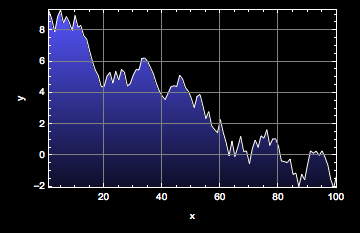Here is another method that uses the more general gradient background construction I posted as an answer to "How can I set different opacity values for the background of a ListPlot""How can I set different opacity values for the background of a ListPlot".
This answer is rather late, but I thought it's a good example of how else to use the simple option Prolog -> gradientBackground to create a gradient background:
gradientBackground =
With[{bottomColor = Black, topColor = Lighter[Blue]},
Inset[Show[
Rasterize[
Graphics[
Polygon[{{0, 0}, {1, 0}, {1, 1}, {0, 1}},
VertexColors -> {bottomColor, bottomColor, topColor,
topColor}], PlotRangePadding -> 0, ImagePadding -> 0],
"Image"], AspectRatio -> Full], {Left, Bottom}, {0, 0},
ImageScaled[{1, 1}]]];
bankerData =
Transpose[{Range[100], Accumulate[RandomReal[{-1, 1}, 100]] + 10}];
ListLinePlot[
bankerData,
Prolog -> gradientBackground,
PlotRangePadding -> None,
Frame -> True,
Axes -> False,
GridLines -> Automatic,
PlotStyle -> White,
FrameLabel -> {"x", "y"},
Method -> {"GridLinesInFront" -> True},
PlotRegion -> {{.04, .96}, {.04, .96}},
Background -> Black,
Filling -> Top,
FillingStyle -> Black,
PlotRange -> All,
BaseStyle -> {White, FontFamily -> "Arial"}]

